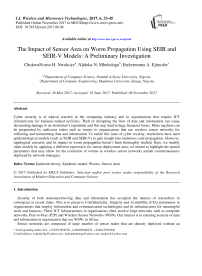The Impact of Sensor Area on Worm Propagation Using SEIR and SEIR-V Models: A Preliminary Investigation
Автор: ChukwuNonso H. Nwokoye, Njideka N. Mbeledogu, Ihekeremma A. Ejimofor
Журнал: International Journal of Wireless and Microwave Technologies(IJWMT) @ijwmt
Статья в выпуске: 6 Vol.7, 2017 года.
Бесплатный доступ
Cyber security is of topical concern in the computing industry and in organizations that require ICT infrastructure for business-related activities. Theft or disrupting the flow of data and information can cause devastating damage to an institution’s reputation and this may lead to huge financial losses. More mayhem can be perpetrated by malicious codes such as worms to organizations that use wireless sensor networks for collecting and transmitting data and information. To tackle this issue of cyber security, researchers have used epidemiological models (such as SEIR and SEIR-V) to gain insight into malicious code propagation. However, topological concerns and its impact in worm propagation haven’t been thoroughly studied. Here, we modify older models by applying a different expression for sensor deployment area; we intend to highlight the spatial parameters that may allow for the extinction of worms in wireless sensor networks amidst countermeasures deployed by network managers.
Epidemic theory, Epidemic model, Worms, Sensor Area
Короткий адрес: https://sciup.org/15013004
IDR: 15013004
Список литературы The Impact of Sensor Area on Worm Propagation Using SEIR and SEIR-V Models: A Preliminary Investigation
- Adebayo S, Akinwunmi AO, Aworinde HO. Increasing agricultural productivity in Nigeria using wireless sensor network (WSN ). IEEE African Journal of Computing & ICT 2015; 3: 121–128.
- Akyildiz IF, Su W, Sankarasubramaniam Y, Cayirci E. Wireless sensor networks: A survey. computer networks 2002, 4: 393–422.
- De P, Liu Y, Das SK. Modeling node compromise spread in wireless sensor networks using epidemic theory. International Symposium on a World of Wireless, Mobile and Multimedia Networks 2006: 237–243.
- Diekmann O, Heesterbeek JAP, Metz JAJ. On the definition and the computation of the basic reproduction ratio R0 in models for infectious diseases in heterogeneous populations. Journal of Mathematical Biology 1990, 4: 365–382.
- Feng L, Song L, Zhao Q, Wang H. Modeling and stability analysis of worm propagation in wireless sensor network. Mathematical Problems in Engineering 2015.
- Yaeghoobi BK, Soni MK, Tyagi SS. Dynamic and real-time sleep schedule protocols for energy efficiency in WSNs. I. J. Computer Network and Information Security 2016, 1: 9–17.
- Kermack WO, McKendrick AG. Contributions to the mathematical theory of epidemics. ii. the problem of endemicity. Proceedings of the Royal Society of London, Series A 1832; v138i834: 55–83.
- Kermack WO, McKendrick AG.. A contribution to the mathematical theory of epidemics. Proceedings of the Royal Society of London A: mathematical, physical and engineering sciences, The Royal Society 1927;, 700–721.
- Kermack WO, McKendrick AG. Contributions to the mathematical theory of epidemics. III. Further studies of the problem of endemicity. Proceedings of the Royal Society of London. Series A, Containing Papers of a Mathematical and Physical Character 1933; 843: 94–122.
- Lule E, Bulega TE. A scalable Wireless Sensor Network (WSN) based architecture for fire disaster monitoring in the developing world. I. J. Computer Network and Information Security 2015; 2: 40–49.
- Mishra BK, Keshri N. Mathematical model on the transmission of worms in wireless sensor network. Applied Mathematical Modelling 2013, 6: 4103–4111.
- Mishra BK, Pandey SK. Dynamic model of worms with vertical transmission in computer network. Applied Mathematics and Computation 2011, 21: 8438–8446.
- Mishra BK, Saini D. Mathematical models on computer viruses. Applied Mathematics and Computation 2007; 2: 929–936.
- Mishra BK, Saini D. SEIRS epidemic model with delay for transmission of malicious objects in computer network. Applied Mathematics and Computation 2007; 2: 1476–1482.
- Mishra BK, Tyagi I. 2014. Defending against malicious threats in wireless sensor network: A mathematical model. International Journal of Information Technology and Computer Science 2014; 3: 12–19.
- Nwokoye CH, Umeh I, Nwanze M, Alao BF. Analyzing time delay and sensor distribution in sensor networks. IEEE African Journal of Computing & ICT 2015, 1: 159–164.
- Nwokoye CH, Ejiofor VE, Orji, R, Umeh I. Investigating the effect of uniform random distribution of nodes in wireless sensor networks using an epidemic worm model. Proceedings of the 2nd International Conference on Computing Research and Innovations 2016, 58–63.
- Tang S, Mark BL. Analysis of virus spread in wireless sensor networks: An epidemic model. 7th International Workshop on the Design of Reliable Communication Networks, DRCN 2009: 86–91.
- Wang Y, Yang X. Virus spreading in wireless sensor networks with a medium access control mechanism. Chinese Physics B 2013, 4: 40206.
- Zennaro M, Pehrson B, Bagula A. Wireless sensor networks: A great opportunity for researchers in developing countries. 2nd IFIP Intl Symp. on Wireless Communications and Information Technology in Developing (Countries, South Africa) 2008.
- Zennaro M, Pehrson B, Bagula A. Wireless Sensor Networks : A great opportunity for researchers in Developing Countries.
- Singh A, Snigdh I. Modelling failure conditions in zigbee based wireless sensor networks. International Journal of Wireless and Microwave Technologies (IJWMT), 2017; 2: 25-34, 2017.
- Palani S. Providing useful data reliably to mobile cloud users from random wireless sensor network. International Journal of Wireless and Microwave Technologies (IJWMT) 2017; 1: 49-62.


